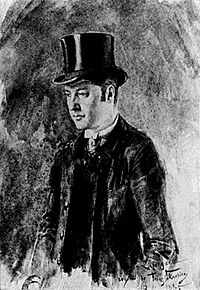Jules Laforgue facts for kids
Quick facts for kids
Jules Laforgue
|
|
|---|---|

Portrait by Franz Skarbina (1885)
|
|
| Born | 16 August 1860 Montevideo |
| Died | 20 August 1887 (aged 27) Paris |
Jules Laforgue (born August 16, 1860 – died August 20, 1887) was a poet from France and Uruguay. He is often called a Symbolist poet. Symbolism was a movement where artists used symbols to express ideas and emotions. Some people also think his poetry was influenced by Impressionism, a style of painting that focuses on light and color. Laforgue even modeled for the famous painter Pierre-Auguste Renoir. He appeared in Renoir's 1881 painting Luncheon of the Boating Party.
Contents
Early Life and Family
Jules Laforgue was born in Montevideo, Uruguay. His parents, Charles-Benoît Laforgue and Pauline Lacollay, met there. His father worked as a teacher and then at a bank. Jules was the second of eleven children. His older brother, Émile, later became a well-known sculptor.
In 1866, when Jules was six, his family moved back to France. They settled in Tarbes, which was his father's hometown. However, in 1867, his parents decided to return to Uruguay. They took their nine younger children with them. Jules and his older brother Émile stayed in Tarbes. They were raised by a cousin's family.
Moving to Paris and Education
In 1876, Jules's father brought the family to Paris. The next year, in 1877, his mother passed away. Jules was not a very good student in school. He failed his baccalaureate exams, which are important tests in France. He failed them again in 1878, and then a third time.
Even though he struggled in school, Jules loved to learn on his own. He started reading many famous French authors. He also spent time visiting the museums in Paris. This helped him learn a lot about art and literature.
Starting a Literary Career
In 1879, Jules's father became sick and went back to Tarbes. But Jules stayed in Paris. He published his first poem in Toulouse. By the end of that year, he had published several poems. Important writers started to notice his talent.
In 1880, Jules became part of the literary groups in Paris. He became a student and friend of Paul Bourget. Bourget was the editor of a magazine called La Vie moderne.
Influence of Art and Impressionism
A lot happened to Laforgue in 1881. He took classes from a famous thinker named Hippolyte Taine. Jules also became very interested in painting and art. Charles Ephrussi, a wealthy art collector, hired Laforgue as his secretary. Ephrussi was one of the first people to collect Impressionist art.
Many people who study Laforgue believe that Impressionism greatly influenced his early poetry. Some think he tried to create a literary version of Impressionism in his poems. In 1881, Laforgue wrote a novel called Stephane Vassiliew. He also started a collection of poems called The Tears of the Earth, but he later decided not to publish it. Some of those poems were used in his later work, Les Complaintes.
Around this time, he also started going to a famous cabaret called Le Chat Noir. He adopted a playful, joking style called fumisterie. This style came from a clown character named "Pierrot fumiste" in cartoons. When his father died, Laforgue did not attend the funeral.
Time in Berlin and Later Life
From November 1881 to 1886, Jules Laforgue lived in Berlin, Germany. He worked as a French reader for the Empress Augusta. This job was like being a cultural advisor. He was paid well, which allowed him to freely follow his interests. In 1885, he wrote L'Imitation de Notre-Dame la Lune, which many consider his best work.
In 1886, he returned to France. He married an Englishwoman named Leah Lee. That same year, his poems were published in a magazine called La Vogue. His poem "L'Hiver Qui Vient" ("The Coming Winter") was one of these. He felt this poem set the tone for his future writing.
Sadly, Jules Laforgue died the next year, in 1887. He was only 27 years old, passing away four days after his birthday. He died from tuberculosis, a serious lung disease. His wife, Leah, also died shortly after him. When he passed away, he left behind an unfinished book of poems and an unfinished essay.
His Influence and Style
Jules Laforgue was one of the first French poets to write in free verse. This means his poems did not always follow strict rules of rhyme and rhythm. He was influenced by the American poet Walt Whitman. Laforgue even translated some of Whitman's poems, which influenced other French poets like Gustave Kahn.
Laforgue was also a follower of the philosophers Arthur Schopenhauer and Karl Robert Eduard von Hartmann. Their ideas often involved a sense of sadness or a belief that life is difficult.
His poetry had a big impact on later poets. Two very famous poets, Ezra Pound and T. S. Eliot, were greatly influenced by Laforgue. For example, Eliot's famous poem Prufrock shows a clear influence from Laforgue's style.
Major Works
- Soir de Carnaval (around 1880)
- Stéphane Vassiliew (written in 1881, but not published until 1943)
- Les Complaintes (1885)
- L'Imitation de Notre-Dame la Lune (1886)
- Moralités légendaires (1887)
- Des Fleurs de bonne volonté (published after his death in 1890)
- Derniers vers (published after his death in 1890)
- Berlin, la cour et la ville (published after his death in 1922)
- Triste triste (published after his death in 1967)
See also
In Spanish: Jules Laforgue para niños

